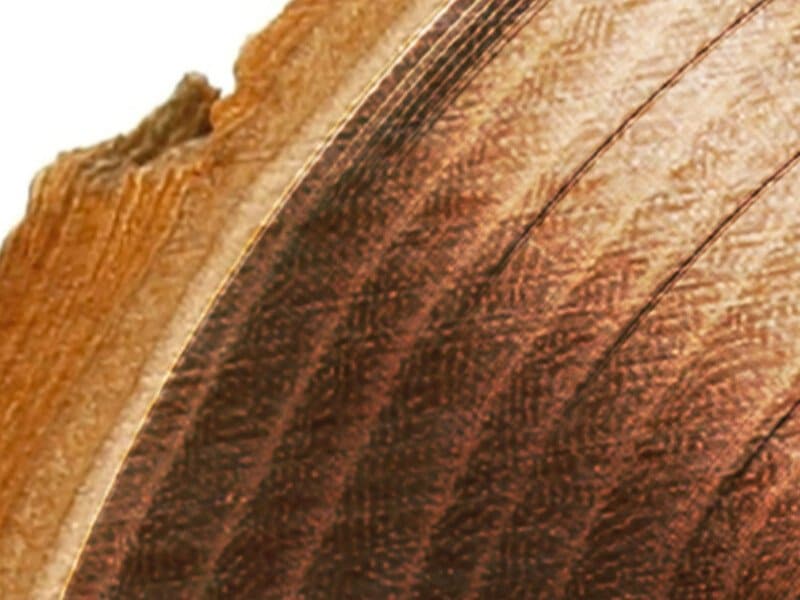
Scotland’s best-kept secret
Technologies for joineries

We discover Haldane UK, a company whose five-axis woodwork adorns palaces and castles but whose name is known only by cognoscenti who seldom share it.
You could be forgiven for thinking Scotland’s best-kept secret might be a rare single malt whisky, the view across a beautiful glen bordered with fir forests and snow-capped peaks, or a littleknown beach where the sun never dips below the horizon during the summer solstice. I’m sure there are many such secrets in Scotland. It is a land without parallel. But the one I’m thinking of is a secret so rare that those who know of it will not reveal its name or its whereabouts.
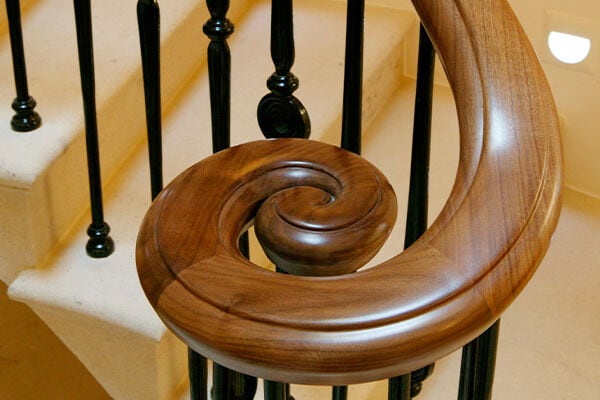
This secret is behind some of the most prestigious restoration projects in Britain. It’s been instrumental in creating exquisite ceilings for castles, decorative woodwork for palaces, complex furniture components for the world’s finest hotels, copy antique hand rails and staircase components for listed buildings, panelling for prestigious shopping centres, intricate friezes adorned with complex inscriptions for university libraries, carvings and columns… The list is endless. If it’s complicated, it’s three-dimensional, it’s curved and it will take skilled craftsmen days or weeks to make it from wood, this secret has the expertise and the equipment to produce it in hours, sometimes just minutes – and once you know who it is, it could be as beneficial to your business as it is invaluable to the countless cognoscenti on its client list who will never share its name. I’m about to break the secret. I will share it with you.
Scotland’s best-kept secret is a specialist in five-axis machining called Haldane; Haldane UK of Glenrothes; the secret subcontractor whose identity top-flight architects, designers and furniture manufacturers will not reveal because what Haldane can’t make with its fleet of five-axis machines has yet to be discovered. And to a man, every Haldane client likes to keep that to themselves.
Haldane’s story began shortly after the Second World War. A small wood-turning company, much of its work was cooperage for the whisky distilleries and bobbins for weavers. Spinning Jennys followed. “We held the global market for spinning wheels,” Managing Director, Forrester Adam told me.
“When I joined the company in the early ‘90s, the most technical thing we had was a fax machine in the office but we could carve, we could turn wood and we were very good at it.”
The advent of five-axis CNCs was a real turning point for Haldane: “Our first five-axis machine was £250,000 and it cost us another £50,000 for the software to run it. We had to employ a student from Edinburgh to program it for us. Most companies that bought into five-axis machines were using them for metal. We must have been the first in the UK to use a five-axis machine for wood.
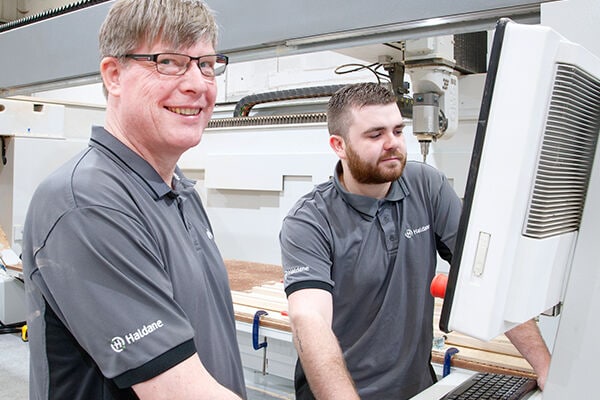
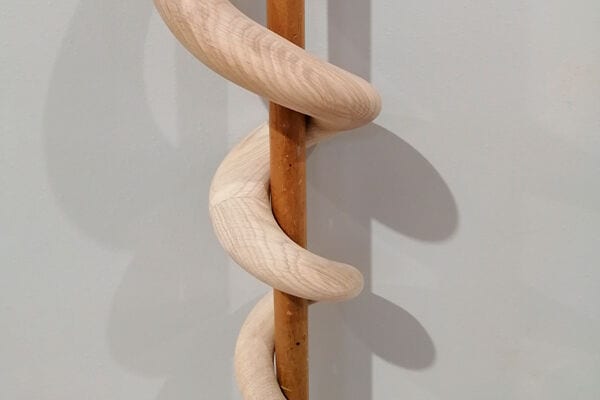
“With our first 5-axis machine, we wanted to become the UK's leading specialist sub-contract timber machining company enabling woodworkers, metalworkers and furniture companies to benefit from the accuracy and efficiency we could deliver. One of the most notable projects we did was for Windsor Castle when it burned down. The ceiling was made up of components about the size of a brick – eight designs, all twisted. It was taking one guy a day and a half to carve each one and there were 950 to make. They gave the job to us and we made each one in 40 minutes.”
As the workload increased and the complexity of the work they could take on grew, Haldane bought more five-axis machines and broadened its product offer into glazing beads, circular and shaped cassettes for doors, complex handrails and commercial work for theme parks, shopping centres and cruise ships. “We’ve always had a toe-dip in furniture with people who wanted components making. We can machine their materials, or we can procure, machine and polish.
“We’re very responsive to the market. We always want to know how can we do things better, faster, or more competitively and when we spot a gap we’ll invest. We’ve recently invested in 3d scanning and we have two scanners that we can use on site or here in the factory. We get in an old piece of timber – part of a listed building, for example – and we can scan it to within 30 microns, redevelop it and give it to the client as a 3d-rendered product that we can produce thousands of. We were always seen as bespoke manufacturers, specialists in one-off complex pieces, but now, with our latest machine, we can offer large volume work. That’s really what prompted us to invest in a new and much larger five-axis machine: we knew it would help us open up new markets and it has. It’s given us new opportunities, enabled us to produce volume and made us very competitive.”
Haldane’s most recent investment, an SCM’s hypsos, is much bigger than any of the company’s other five-axis machines. Equipped with a 4.8 x 1.8m bed, it’s ideal for taking on volume contracts involving products much larger than the complex components and handrails the other CNCs are producing. In fact, the bed is so large that production can even be zoned so up to four different projects can be machined without opening the cabin. The hypsos simply jumps from one to the next.
“As soon as you join two pieces of wood together, the cost goes up so even with our most recent five-axis machines, we knew we could be more efficient and competitive. With the new SCM machine, we can be much more competitive. We’re now producing components in seven minutes that would have taken us 27 and the largest piece we can machine is 4.8 metres in length.
“On the furniture side, it’s helped us transform from a bespoke specialist to a contract machining specialist. Whatever you want manufacturing, we can do it now. Forget six-week lead times and four weeks in shipping, plus the cost of a container. Since we took delivery of our SCM, our lead time for standard components can be as little as a few days.”
Just to look at, the SCM hypsos is an impressive machine. It looks purposeful, solid, and the heavyweight tools in both its toolchangers send a strong message that this is a rugged machine capable of handling really heavyweight tasks without baulking. Haldane’s CNC Manager, Derek Jorgensen, has more than 30 years working with five-axis machines and even he is impressed with the hypsos. “This is a big workhorse,” he says. “It copes with anything people want without compromising on accuracy. The only limit to this machine is the limit of your imagination. We bought everything we could get on it as extras. The tool-changer has 16 tools in the back unit and eight on the gantry. We could have had another tool-changer on the gantry but we have the capacity we need for now and both will take big diameter tools. We have clamps, raised pods we can work underneath – the head can go level with the table – bigger pumps to enhance the suction... Everything. And no matter what we put on it, we never get vibration lines.”
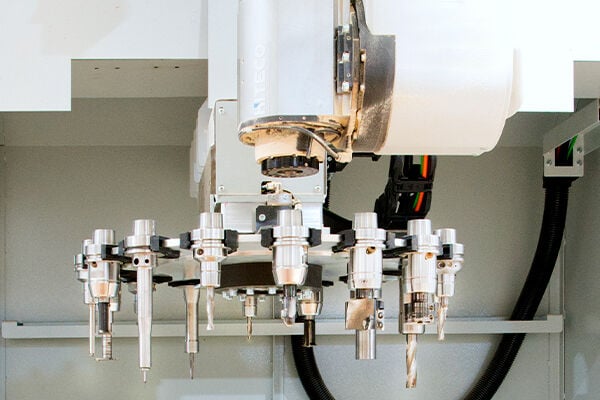
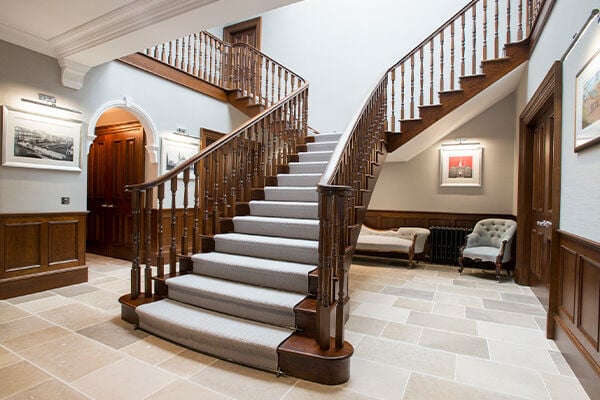
The 28mm thick 4840mm x 1800mm worktable is fixed to the main base and the surface allows distribution of the vacuum as well as the housing of gaskets for delimitation of the suction area. Threaded holes in the 30 x 30mm grid pattern that runs across the entire surface allow the passage of vacuum while also providing mechanical fixing points.
Haldane opted for six 145 x 145mm suction cups, two 145 x 65mm cups and two 145 x 30mm cups along with six horizontal clamps.
The five-axis head unit is SCM’s 15kW PX5, which has two NC-controlled rotating axes allowing rotation in any direction. The electrospindle, which is equipped with an HSK 63F quick release tool-holder, is liquid cooled and has ceramic bearings, ideal for jobs that demand the 24,000rpm maximum rotation speed the PX5 can deliver.
Enhanced rigidity during some machining operations is provided by pneumatic brakes that fix the B and C axis positions while Adaptive Cut dynamic tool effort control keeps the machining performance within the optimal range by adjusting feed speed rates according to the tool in use.
The maximum tool size is a colossal 3kg, 200mm on the gantry, or 6kg and 250mm in the 16-position rear tool store. Both tool-changers are pressurised to keep the shanks clean.
The SCM hypsos is connected via a mobile console with integrated PC - a 21” LCD eye-M Pro touch screen colour display - that runs Windows 10 IoT but it also has two points for remote machine control from where the full protection enclosure can be operated. Maestro active is installed on the control unit, along with performance enhancing Smart Pro software.
“The software is top-of-the-range HMI,” says Derek. “It’s very intuitive. I’ve been working machines like these for a long time and it only took me two weeks to get my head around it. It took six months with the other machines before we reached full commercial operation. Compared with the other machines we have, the hypsos is more of a workhorse. It gives us something unique. Now we’ve got into it properly, it never stops and already we are thinking about having another.”
Coming from a company that knows five-axis machines inside out, I can’t resist asking why Forrester chose SCM. “We’ve seen SCM at a lot of exhibitions and they seem to be getting a lot of traction in the industry,” he told me. “We have experience of most of the others but SCM’s approach was exemplary. The way they came in and developed the project, we couldn’t have asked for more.
The way the tender was laid out was very comprehensible. When they said they would deliver it, they delivered it. The team they brought, their attitude, it was amazing. That engages people. The engineers that came up to commission the machine were incredible.
When they started to install it, I noticed the head had a small amount of surface rust on it. I mentioned it. The engineer phoned up immediately and the next day a new one arrived, no question. Since December last year when it was installed, they have dialled into the machine and done tweaks but other than that it’s been pretty faultless. We always try and buy the best in the marketplace and the SCM was no exception. This is a really high spec machine but it is good value considering what it will do.”
So, with a fleet of five-axis machines and decades of experience few companies can come close to, what’s the next challenge for Scotland’s best-kept secret?
“We need to get the message across that we are keen to start looking at more standard projects as well as the bespoke projects we excel at,” says Forrester. “Sometimes we get recommended but when people find us, they’ve usually never heard of us before. The problem is, they rarely tell anybody else about us either. We need to change that and spread the word that whatever the five-axis project, we have the expertise and the equipment to make it happen and we’re a lot more competitive than buying in from abroad.”
Credits: Melvyn Earle for Furniture Journal
Fill out the online form to be contacted by a salesperson